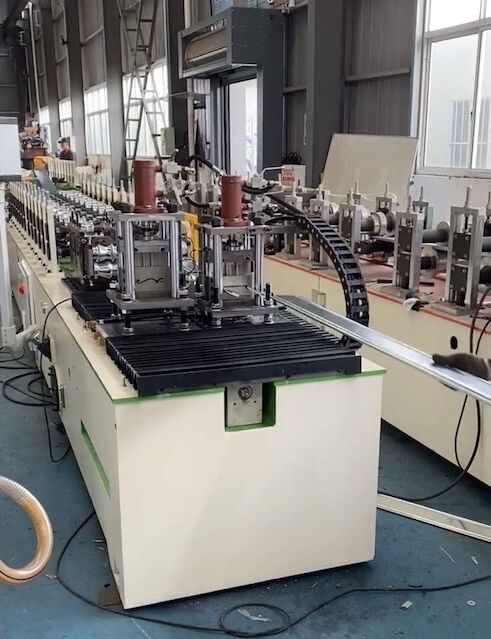Multi Profile Roller Shutter Door Roll Forming Machine
Get a Quote
Send us a message and we’ll get back to you shortly.
Roller Shutter Door Roll Forming Machine Specification
- Multiple Profiles
- Production capacity: 50ft
- Condition: New
- Roller Shutter 6″ Wide
- Channel Thickness: 0.27″ – 0.32″ / 0.5mm – 245
- Applicable Industries: Roller Doors
- Materials: Aluminum, Steel, Galvalume Painted
Multi Profile Roller Shutter Door Machine Description
A multi-profile roller shutter door roll forming machine is a specialized piece of equipment used in the manufacturing of roller shutter doors. Roller shutter doors are commonly used in industrial, commercial, and residential settings to provide security, insulation, and weather protection for openings such as windows, doors, and entrances. These doors consist of a series of interlocking slats or profiles that roll up and down to open and close the opening.
Here's a brief overview of how a multi-profile roller shutter door machine works:
- Material Feeding: The machine begins by feeding a coil of metal material, typically steel or aluminum, into the roll forming section. The coil is mounted on a decoiler, and it is gradually unwound as the manufacturing process progresses.
- Roll Forming: The roll forming section is the heart of the machine. It consists of a series of rollers and tooling that shape the flat metal coil into the desired profile for the roller shutter slats. The machine can be designed to produce multiple profiles simultaneously, hence the term "multi-profile."
- Cutting and Length Control: After the profiles are formed, the machine includes a cutting mechanism to cut the continuous length of formed profiles into individual slats of the desired length. Length control systems ensure that each slat is cut to the correct size.
- Embossing and Perforation (Optional): Depending on the design and functionality of the roller shutter doors, the machine may include additional stations for embossing patterns or perforating holes into the slats for ventilation or visibility.
- Assembly: Some roller shutter door roll forming machines also have the capability to assemble various components of the door, such as end caps, hinges, and locking mechanisms, as part of the manufacturing process.
- Output and Stacking: The finished roller shutter door slats are then conveyed to the output area, where they are stacked or packaged for further assembly or distribution.
These machines are highly automated and can produce roller shutter door slats efficiently and with consistent quality. The specific features and capabilities of a multi-profile roller shutter door roll forming machine can vary depending on the manufacturer and the requirements of the customer. They are commonly used in industries that require the mass production of roller shutter doors, such as industrial building construction, warehouses, and garage door manufacturing.
It's important to note that the design and operation of roll forming machines can vary, and there may be different configurations and features available depending on the manufacturer and the specific needs of the production process.
Roller shutter door profiles
Roller shutter door profiles are the individual slats or sections that make up a roller shutter door. These profiles are typically made of metal, such as steel or aluminum, and they are designed to interlock with each other when the door is in the closed position. Roller shutter door profiles come in various shapes, sizes, and configurations to suit different applications and requirements. Here are some common types of roller shutter door profiles:
- Flat Slats: Flat slats are straight and flat profiles that are commonly used for security roller shutter doors. They provide a solid and smooth surface when the door is closed, offering protection against unauthorized entry, vandalism, and weather.
- Perforated Slats: Perforated slats have small holes or perforations along their surface. These slats are often used in commercial and industrial roller shutter doors to allow for ventilation, visibility, and some natural light while maintaining security.
- Insulated Slats: Insulated slats are designed with a layer of insulation material, such as foam or polyurethane, sandwiched between two metal layers. These profiles are used for thermal insulation and are suitable for applications where temperature control and energy efficiency are important, such as warehouses or cold storage facilities.
- Vision Slats: Vision slats are equipped with transparent or translucent inserts, typically made of polycarbonate or acrylic. These inserts allow natural light to enter the building even when the roller shutter door is closed, providing visibility and security.
- Punched Slats: Punched slats have larger openings or slots along their length, allowing for increased ventilation and visibility while still providing security. They are commonly used in retail and storefront applications.
- Grille Slats: Grille slats have a more open design with closely spaced bars or rods. They are used in applications where security is required, but a higher level of visibility and airflow is desired, such as in shopping malls or parking garages.
- Solid and Perforated Combination Slats: Some roller shutter doors feature a combination of solid and perforated slats. This design allows for a balance between security and visibility.
- Fire-Rated Slats: Fire-rated roller shutter door profiles are designed to meet specific fire safety standards. They are used in buildings where fire protection is crucial, such as in industrial facilities, commercial kitchens, or areas with high fire risk.
The choice of roller shutter door profiles depends on the specific needs of the application, including security requirements, insulation, visibility, and aesthetic preferences. Roller shutter doors can be custom-designed with the appropriate profile configuration to meet these needs. Additionally, roller shutter door profiles may vary in terms of their thickness, material, and finish, further influencing their suitability for different applications.
